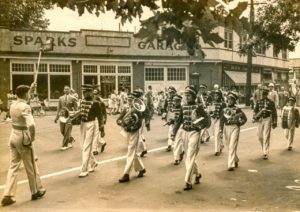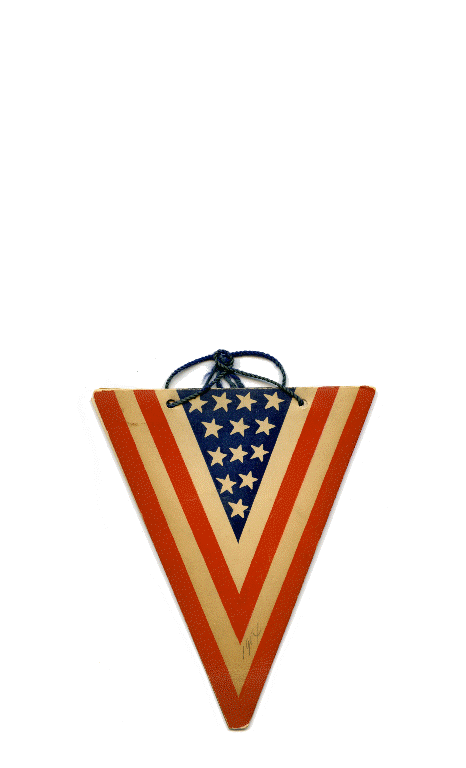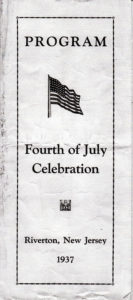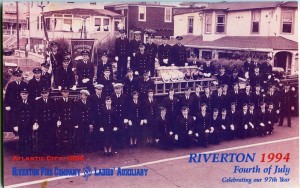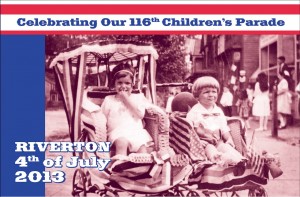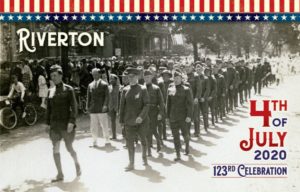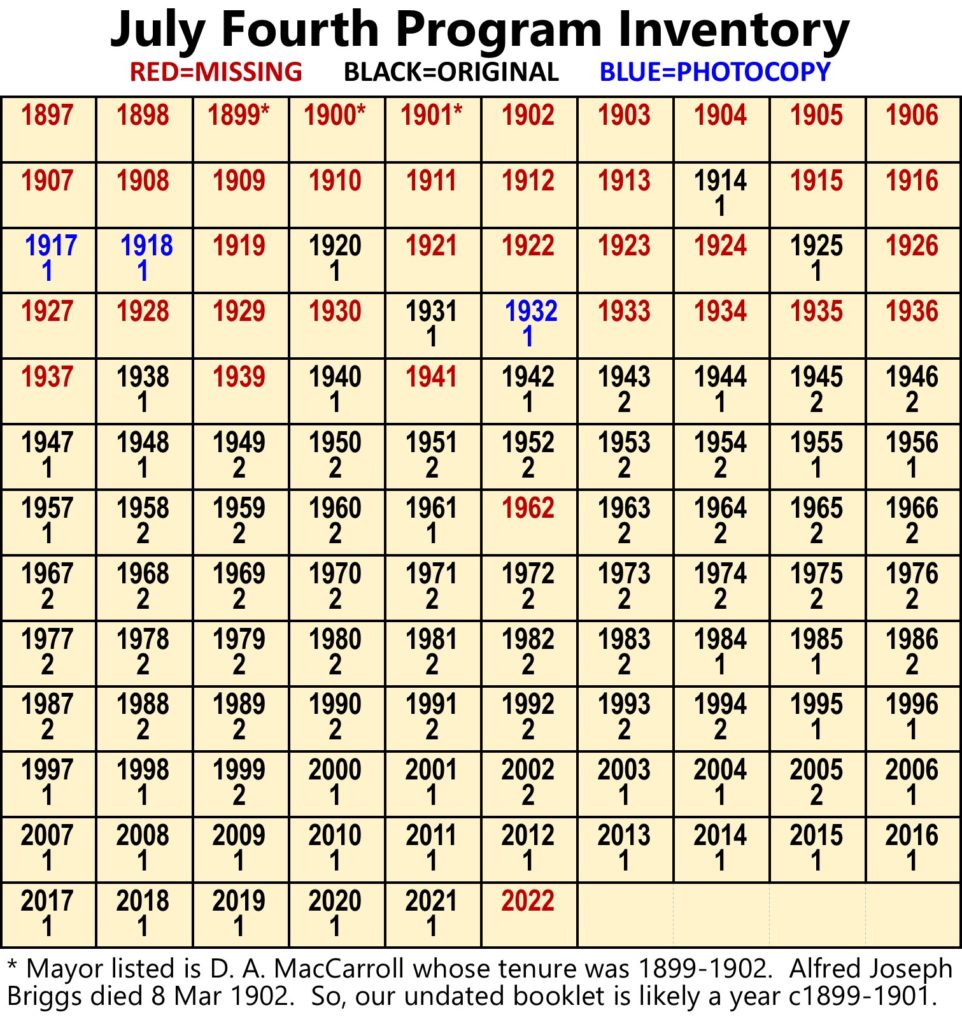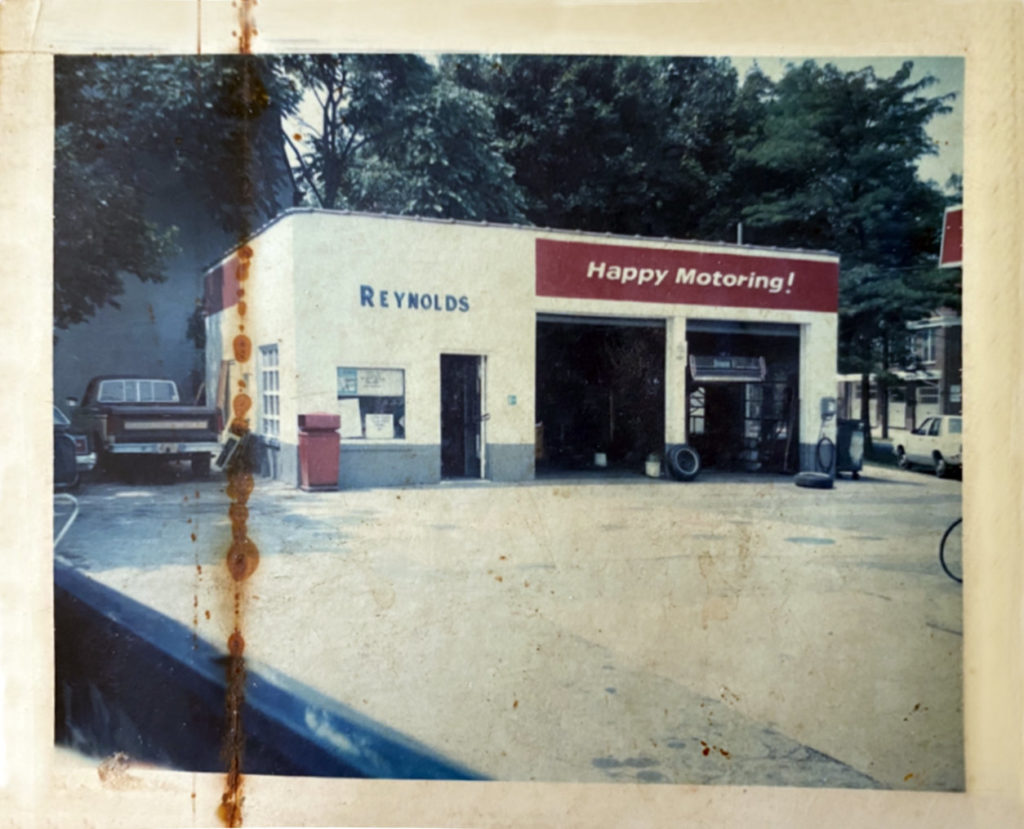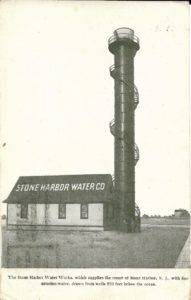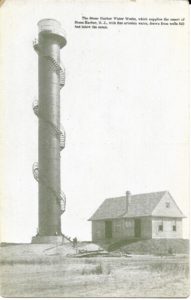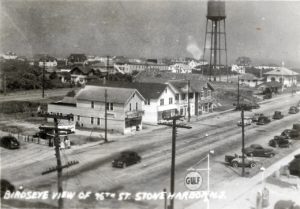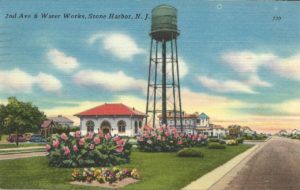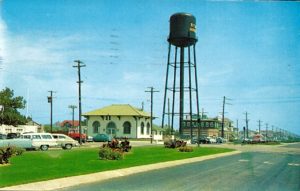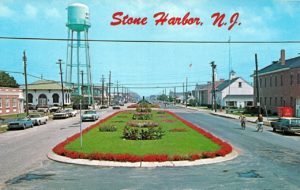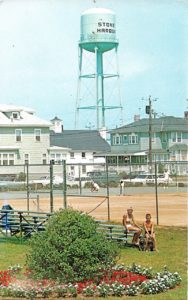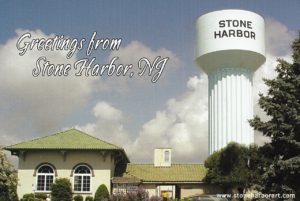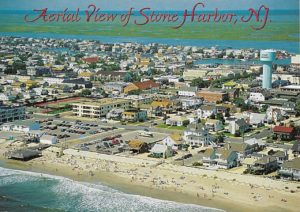Two photos fill in more bits of Riverton history
Pat Solin is still cataloging items in our collection, and she just sent me two scans of bands marching in the July 4th Parades of 1944 and 1945, respectively.
 Please let us know if you can identify the band in the 1945 photo or can spot a family member in the Palmyra High School Band.
Please let us know if you can identify the band in the 1945 photo or can spot a family member in the Palmyra High School Band.
Now, if we just had a 1945 Tillicum Yearbook… hint-hint.
Click on that 1944 photo for a larger view and note the American Store next to Sparks and Keating’s Drugstore farther down, at the corner.
![]()
![]() When you click on a photo for a larger view, look for the information icon, and click on that to reveal the “view full-size” link below for an even larger view.
When you click on a photo for a larger view, look for the information icon, and click on that to reveal the “view full-size” link below for an even larger view.
We still have a wish list of long-gone businesses for which we’d like to have photos. Two examples: Mrs. Alfred Smith’s Store and The Sharon Shop operated out of 414 Main, albeit at different times. Look through those old family albums and see what more history you can find.
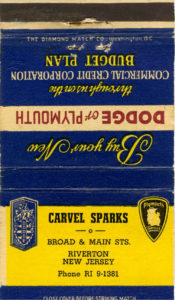 But the real bonus for this master of minutiae is that in the 1944 photo, we finally have a street view that shows the Carvel Sparks auto dealership that I wrote about two years ago – an essay sparked by an old matchbook.
But the real bonus for this master of minutiae is that in the 1944 photo, we finally have a street view that shows the Carvel Sparks auto dealership that I wrote about two years ago – an essay sparked by an old matchbook.
See more about the Carvel Sparks Dodge/Plymouth auto dealership in the April 2020 post below.
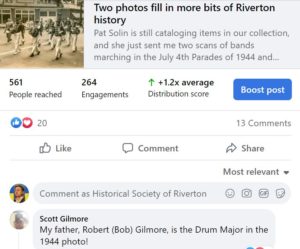 Added 4/26/2022: A problem with Facebook is that comments, likes, and loves, made there don’t add to the historical record we are trying to create here.
Added 4/26/2022: A problem with Facebook is that comments, likes, and loves, made there don’t add to the historical record we are trying to create here.
This Facebook post earned much better reader engagement numbers than our usual and one comment, in particular, is worth preserving here.
Air Force veteran Scott Gilmore, a former Cinnaminson resident now living in Wichita Falls, TX, tells us that his father, Robert Gilmore, was the drum major in the 1944 Palmyra High School Band.
July Fourth Programs give us a glimpse into Riverton’s favorite day
We are still taking stock of items in our archive. Not the least among them are the July Fourth Program booklets. Pat Solin asked that we pass along a request that we’re seeking missing copies of the program booklets, especially those from the early days.
Request for info on Tac-Pal Bridge engineer Ralph Modjeski

Passing along this request from Rick Spector, a Philadelphia-based producer of short videos about Philadelphia history:
Hello, Historical Society of Riverton,
I am doing research on the Tacony-Palmyra Bridge and its chief engineer Ralph Modjeski. Mr. Modjeski also built the Ben Franklin Bridge. He is sadly largely lost to history today. I am looking to interview people who have anecdotes about the bridges, or if I should get really lucky, a story about Mr. Modjeski himself.
My website is moviehouseproductions.com I would greatly appreciate it if you would circulate my information request.
Thanks- Rick Spector
 You asked for it – you got it. (too young for that reference?)
You asked for it – you got it. (too young for that reference?)
Update from a reader to Changes at “The Point” 1851-Present
We are so pleased when a reader contributes images or information that further develops a story. We just received this email from HSR member Mary M. Flanagan:
I saw an article in the Gaslight News recently asking for information on the former service station at 515 Main St. after it passed to John “Jack” Reynolds. I contacted Allen Reynolds who is a son of Jack’s to see if he could contribute any information. Below is what Allen sent to me.
- Prior to 1947 – Charles T. Woolston was the original owner. My father was employee.
- Sept 1947 – Woolston and my father went into partnership (Woolston and Reynolds Service Station).
- Sept 1959 – Woolston opted out of partnership. My father bought Woolston out (Reynolds Service Center).
- However, Woolston continued to own the building, leasing it to my father.
- Jan 1980 – My father dies. I keep business. With my father’s death, building lease expires. I have to purchase it to keep business operating.
- 1986 – Business closed. Building sold to Robert S. Moccia Enterprises, Inc.
That was wonderful of Mary to track down this photo and information. I had to look carefully at that photo in case our old Ford Torino was in there as I often dropped off our car there for service on my way to Riverton School.
Regular visitors may recall Mary’s contribution of scans of remarkable family photos and postcards that I have previously used to illustrate website and newsletter articles. She gave us images of some people, things, and places that literally have no other representation in our records, so in that regard they are priceless. Here are three articles:
Before & After: Discoveries in Historic Preservation, a presentation by Dan Campbell, 7pm Thurs., April 21, 2022
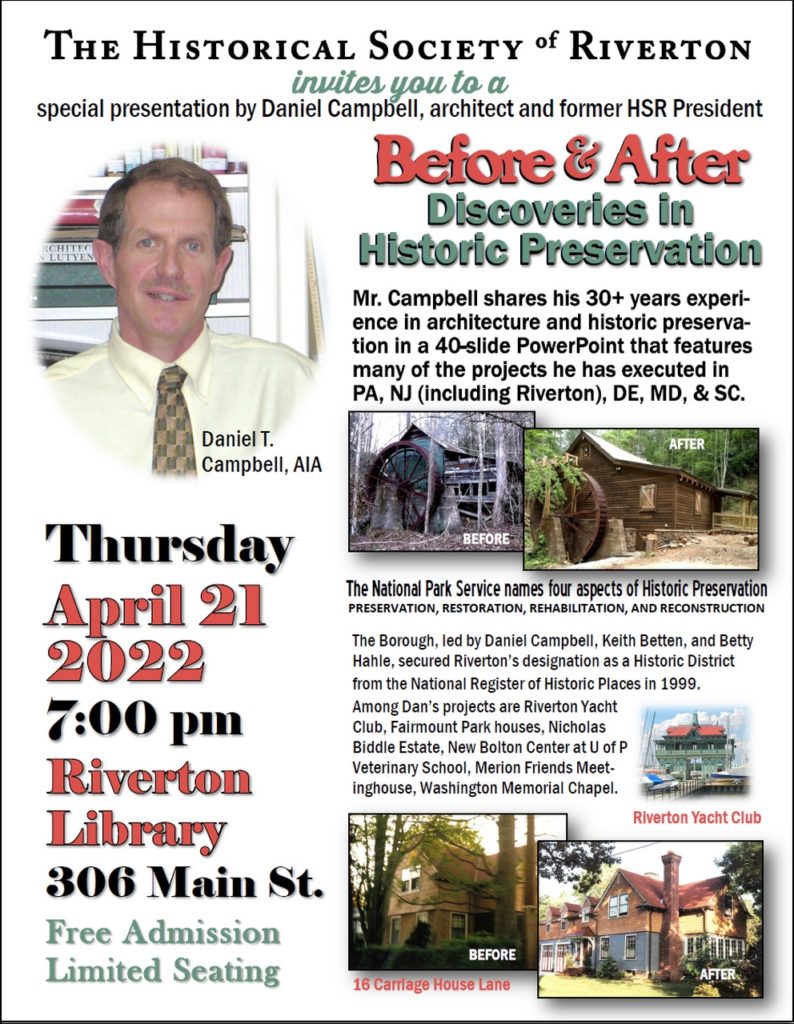 Daniel Campbell, AIA, is a widely recognized multi-state licensed architect whose specialty is the restoration and preservation of historic architecture. He is also a past HSR president and former Gaslight News editor.
Daniel Campbell, AIA, is a widely recognized multi-state licensed architect whose specialty is the restoration and preservation of historic architecture. He is also a past HSR president and former Gaslight News editor.
During his eighteen years in Riverton, Mr. Campbell restored and rehabilitated his residence at 16 Carriage House Lane while designing four new residences.
Dan was part of the Riverton Steamboat Landing Foundation Project Team that completed the restoration of the Riverton Yacht Club. The project won a 2001 NJ State Historic Preservation Project Award.
In 1999, after several years of careful and exhaustive research by Society members and the Borough led by Daniel Campbell, Keith Betten, and Betty Hahle, the National Register of Historic Places designated Riverton Historic District.
Mr. Campbell’s 40-slide PowerPoint incorporates many detailed drawings and photos of projects he has executed over his career in PA, NJ (including Riverton), DE, MD, & SC.
A phone call today confirmed that masks are not required for this event, but anyone may wear one if they wish.
A 100 Year Pictorial Survey of the Water Works at Stone Harbor, NJ
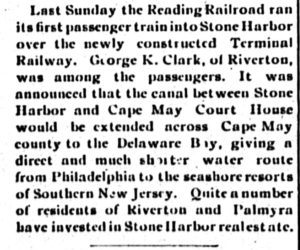
With the return of Daylight Savings Time and warmer temps, our thoughts wander to visits to the Jersey Shore.
But which one? LBI, Avalon, Ocean City, and Wildwood are all favorites, but Riverton folks have been going to Stone Harbor since its early days.
Postcard collector and local history buff Harlan B. Radford Jr. elaborates below on a classic landmark of that resort – the Water Works.
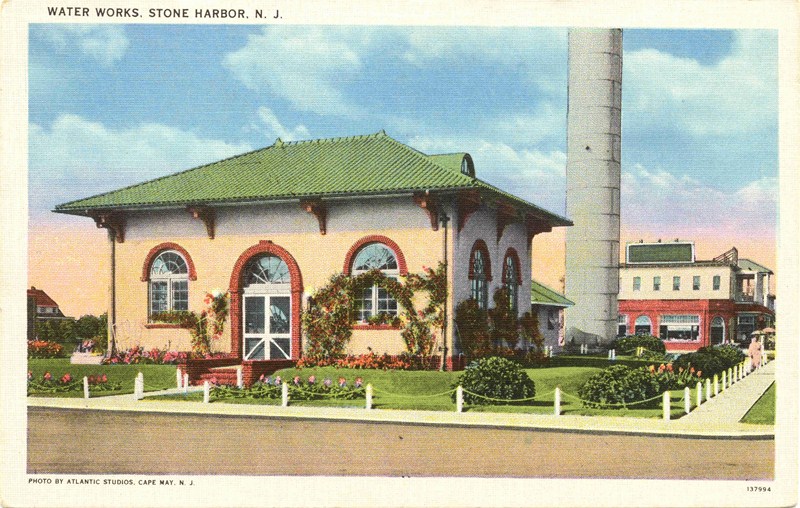
by Harlan B. Radford Jr.
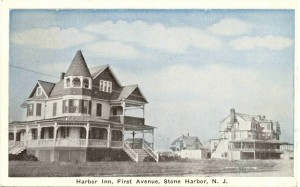
The Risley Brothers, developers of Stone Harbor, recognized that if their enterprise was to succeed, it needed an ample supply of clean and safe water. The city water supply soon replaced private wells such as the one that served the Harbor Inn over near 80th Street with gasoline engine-powered water pumps.
In the winter of 1908-1909, the Risley Brothers completed an artesian waterworks system at 96th Street and Second Avenue with a well that tunneled to a depth of 856 feet and accessed a geological water-bearing formation known as the Kirkwood Aquifer. The 10-foot diameter vertical standpipe on that first pumping station stood 100 feet high and held 60,000 gallons of water.
The following selection of vintage images and information will highlight key moments in Stone Harbor’s waterworks history.
Note the circular stairs ascending to the top of the standpipe in these two postcards that depict the newly completed waterworks, but from two different vantage points.
Harry S. Parks, the engineer, took the photo on the left of this two-part image which shows the interior of the Stone Harbor water pump house that went into service in 1909 or 1910.
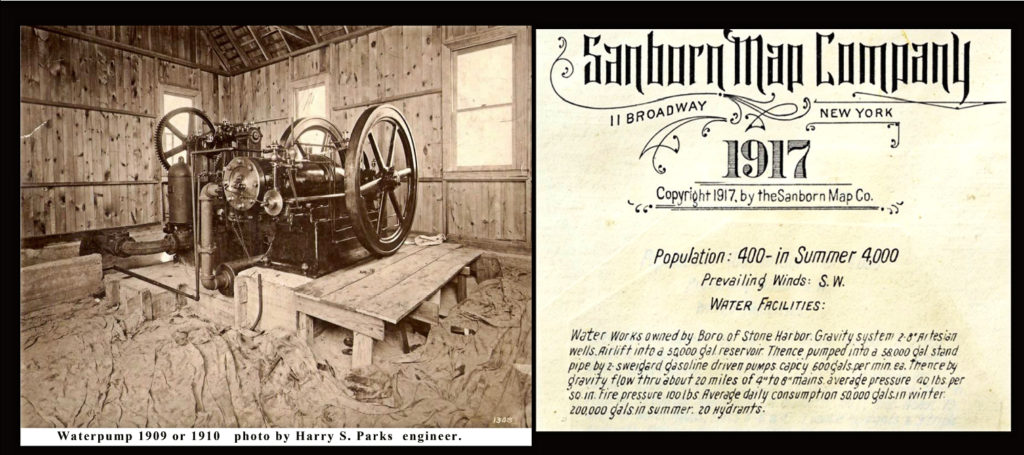
On the right, a scan of a section of the 1917 Sanborn Insurance Map of Stone Harbor details the specifications of the water facilities.
Sanborn Map Company / 11 Broadway / New York / 1917 / Copyright 1917, by the Sanborn Map Co. Population: 400- in Summer 4,000 / Prevailing Winds: S.W. / WATER FACILITIES: Water Works owned by Boro. of Stone Harbor. Gravity system 2-8″ Artesian wells. Airlift into a 50,000 gal. reservoir. Thence pumped into a 58,000 gal. stand pipe by 2-sweigard gasoline driven pumps. capcy 600gals. per min. ea. Thence by gravity flow thru about 20 miles of 4″ to 8″ mains. average pressure 40 lbs. per sq. in. Fire pressure 100 lbs. Average daily consumption 50,000 gals. in winter: 200,000 gals. in summer. 20 hydrants.

A photo from that period shows the pump house and standpipe and reveals five workers, three of whom stand at the base of the standpipe, another worker ascends the circular stairs about halfway up, and a fifth workman is at the very top level of the standpipe. At least 10 to 12 large houses loom in the distant background in this early north-facing view.
This rare antique ocean-facing photo below features the new water works and shows a Pennsylvania Railroad train parked along Second Avenue.
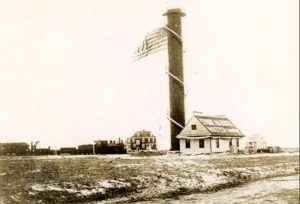
It is possibly a work train that appears to be carrying some freight or construction materials, has a lifting crane for loading and unloading, and has at least one attached passenger or personnel car.
Also, the pump house roof now boldly displays four words in large white letters – “STONE HARBOR WATER Company.” Festive patriotic bunting frames the pump house and traces the entire spiral staircase, and a huge American flag is flapping in a strong breeze at the top of the standpipe in this spectacular photo taken around 1910.
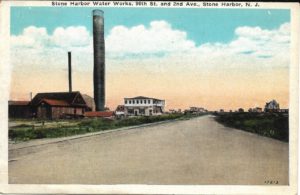
This early c1920s view captures the Stone Harbor water works and Diller’s Store on 95th Street, looking north along the expansive Second Avenue. Several cottages and residential homes in the distance line First Avenue.
By 1924, increased demand for a safe and dependable water supply for the fast-growing community required the construction of another pumping station and newly installed pumps at the same 96th Street location and a new, second well drilled to a depth of 890 feet.
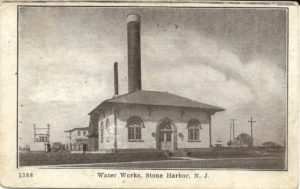
Postmarked in 1925, just one year after the completion of the new pumping station, this black and white postcard is one of the earliest known views of the water works with the standpipe behind the new pumping station. This second pumping station is Stone Harbor’s oldest public building.
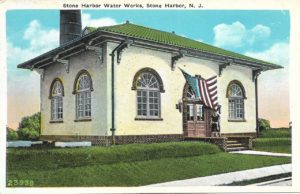
The Water Works’ distinctive Mediterranean style architecture and its classic tile roof made the pumping station a well-recognized, even iconic, Stone Harbor landmark. A large American flag adorns the front-door entrance to this building in this vivid color postcard.
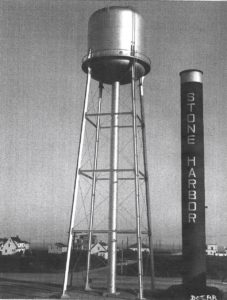
Sometime during the 1940s, the original standpipe or water tower proved insufficient, and a replacement tower with a capacity of 150,000 gallons was approved and built.
This new second water tower had a very different silhouette and consisted of a large holding tank perched atop a four-legged structure with a large water pipe running from the ground up. A third well drilled at 92nd Street and Second Avenue in 1949 to a depth of 878 feet added additional capacity.
Until the original tower on the right was dismantled and removed, the new, larger 1940s water tower and its 1909 predecessor stood side by side for several months.
The following three postcards, provided in a chronological sequence, depict views of the 1940s replacement tower taken over some 10-15 years.
Captured in either 1946 or 1947 from an upper floor of the Shelter Haven Hotel, the real photo postcard view at left shows some undeveloped parcels of land evident along the 96th Street business district. The linen postcard was mailed in 1955, and the chrome postcard was sent in 1961. During this time, a fourth freshwater well was dug in 1955 to a depth of 965 feet at 101st Street and Second Avenue.
Sometime in the early 1960s, the borough changed the paint color of the water tower from a darker blue-gray hue to a less dramatic light green color, as these two more modern chrome postcards show.
Grassy islands with lush flowers run along the middle of Second Avenue, with many still recognizable and notable public buildings in the foreground. The water tower is prominent in the background of the photo of the municipal tennis courts.
These last two continental-size modern-era postcards picture the latest and current water tower version that was constructed in 1978. The elevated single-column hydropillar design water tank stands 133 feet high and has a 500,000-gallon capacity.
This water tower structure features a vertical fluted support column substantially different in size and basic appearance from its two predecessors. Presently, four wells supply water for Stone Harbor, which is then aerated and disinfected before being distributed through approximately 150,000 feet of pipe to more than 2,900 customers.
For more than a century, Stone Harbor has kept pace with the ongoing need to provide its residents with dependable, safe drinking water. Besides serving their practical use, the three different water towers have also provided elevated vantage points that have yielded some excellent photographic images of the changing face of the downtown business district over time.
*Stone Harbor: One Hundred Years of the Seashore At Its Best, Copyright Exit Zero Press – First Edition 2014 – Exit Zero Press, 109 Sunset Boulevard, Suite D, Cape May, N.J. 08204
Harlan Radford also contributes to the Stone Harbor Museum website and Facebook page.
First Annual HSR History Writing Prize – open to Riverton high school students
After a lengthy Covid-related delay, the Historical Society of Riverton is excited to announce our first annual History Writing Prize!
It seems like a lifetime ago, but you may recall our Historic House Party in November 2019.
Heather Macintosh Huffnagle, House Party Chair, conceived the idea to host the affair to raise funds to support excellence in history writing using the HSR’s archives by providing cash awards to students.
The event raised $4,000, but the disruption to school routines and the cancellation of our meetings caused a two-year delay in implementing the new writing program.
Entry due date: May 15, 2022
Summary:
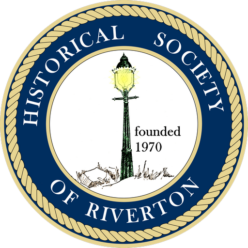 The Historical Society of Riverton (HSR) will award a cash prize of $500 for a 1000 word essay that answers a question about Riverton’s history. The winning entry will be featured on the HSR’s website: http://www.rivertonhistory.com. Noteworthy essays that do not win the primary prize may also be published on the HSR’s website. Essays will follow MLA guidelines for published works (see General Guidelines for Submissions below).
The Historical Society of Riverton (HSR) will award a cash prize of $500 for a 1000 word essay that answers a question about Riverton’s history. The winning entry will be featured on the HSR’s website: http://www.rivertonhistory.com. Noteworthy essays that do not win the primary prize may also be published on the HSR’s website. Essays will follow MLA guidelines for published works (see General Guidelines for Submissions below).
The Question:
“During the middle years of the nineteenth century, the United States experienced many dynamic changes, including the extensive growth of industry and cities, advances in modes of transportation, and political and social conflicts surrounding the issue of slavery. Riverton was founded in 1851. Please research and describe how any of these changes may have influenced where, why, and by whom the town was founded.”
Our website (http://www.rivertonhistory.com) includes many photographs, maps, and articles on Riverton’s history that may help inform and illustrate your essay.
Who may submit an entry?
Any high school student living in Riverton may apply.
How are essays submitted?
Students may submit their essays and questions about the prize to HSR’s Membership Chair Heather Huffnagle at heather.mary.macintosh@gmail.com
Review Committee
HSR Board Members and professionals among its membership with education and/or experience in historical research, education, and writing comprise the Review Committee.
Timeline:
Entries will be accepted until May 15. Awardees will be contacted on May 31.
General Guidelines for Submissions
MLA Paper Format General Guidelines
-
- Use standard 8.5 x 11 white paper.
- Number your pages.
- 1-inch margins (all sides)
- Readable font
- Double-spaced
- Indent new paragraphs.
- Only one space between sentences
MLA cover page includes a few things like:
-
- Title of your paper
- Your name
- Your email
- Your school’s name
What should an MLA paper look like?
An MLA paper has a standard look for every page, including 1-inch margins, a readable font, a running header including your last name and page number, and author-page in-text citations. At the end of your paper, you will include works cited with a list of all the sources used in the paper.
East Riverton – Then & Now
Q: What do Riverton Gun Club, a stud bull named Pinochle Prince, a 1990s Halloween hayride, and the Villages at Cinnaminson Harbour have in common?
A: They all occurred at the same place but at different times. Here’s how.
In July 2020, my wife and I moved from Delran to a townhouse in East Riverton, within the Township of Cinnaminson. It’s a stone’s throw from Riverton, just across the Pompeston Creek.

If not for a defeated 1913 bill in the New Jersey Legislature that would have allowed its annexation, East Riverton might have been part of Riverton.
For the history of the early development of Riverton, I refer to three of Betty Hahle’s “Yesterday” columns.
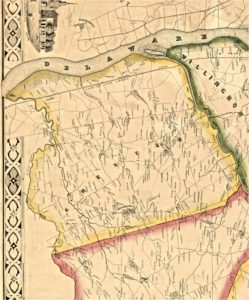
When the founders established the village in 1851, it was a few streets within the larger township of Cinnaminson, which was itself within the much larger township of Chester. Cinnaminson separated from Chester in 1860.
The village grew. In 1877, it added a section from Cottage Ave. to Thomas, from the river to the railroad. The” ‘Thomas Extension” c1882 moved the border down to Elm, and then after 1900, the land above the railroad opened up. Lippincott land began to be developed from the present upper boundaries toward the center of town. (GN 021, Feb 1981)
In December 1893, Riverton separated from Cinnaminson, as a borough. (GN 062, May 1991)

Above the (Pompeston) Creek is East Riverton, largely developed by realtor Charles Price, with the expectation that it would, when developed, become a part of Riverton.

However, in 1913 voters rejected the proposal, and so East Riverton has remained a part of Cinnaminson. Early in this (20th) century, the Riverton Gun Club (RGC) had its grounds along the riverfront there. (GN #088, March 1998)
The competitors at RGC shot live birds; hundreds perished during a typical day of shooting.

In 1904, the NJ Legislature passed a law making it illegal to shoot live birds so two club members decided to test the law’s constitutionality by shooting one in the presence of a constable.
Short story – the club lost.
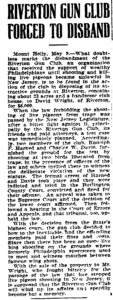
Pat Brunker catches us up on the disbanding of the club from a newsletter article she wrote on the history of the RGC.
A Special Meeting of the Riverton Gun Club was held at the Club House on July 18, 1906. The club decided to carry out the sale of the Club real estate and the Club property.
All household effects were sold (to David H. Wright), and the amount realized was in the neighborhood of $700. (GN #121, March 2006)
David Wright had opposed the shooting of live birds for sport, and after his purchase of the land, Wright renamed the gun club grounds Peace and Plenty Farm.
Advertisements in The New Era indicate that Wright sold milk and hatching eggs and offered the stud services of Pinochle Prince, a registered bull, for a fee of $5.00.
Wright later sold the farm to Joseph Rieder, who operated a cafe and inn on the premises as the Great Depression loomed. (Online inflation calculators claim that $1 in 1932 had the same purchasing power as $20.71 today.)
Rieder passed in 1932, and presumably, the land passed into the hands of another party. The use of that part of East Riverton for the next few decades is unknown. If a reader knows, please send us details, and we will revise this article.
The next time we hear of use for farmland in that area is for a Halloween hayride that existed from about 1993 to 2005.

The hayride’s days were numbered as Cinnaminson Township held a hearing in 1998 for a proposed development of 1,000 townhomes.
However, construction did not get underway until 2004.
Sales of the initial phase of homes began in January 2005, and the last haunted hayride occurred in October 2005.
It took about a century for suburban sprawl – the spread of urbanized areas into the rural landscape – to overtake what once had been Cinnaminson farmland.
Of course, suburban sprawl can negatively affect the environment. Realize, however, that when those men founded Riverton in 1851, they not only originated “…the first wholly planned residential subdivision in America” – they simultaneously started suburban sprawl.
No doubt, the Lenni-Lenape of the 17th century thought, “There goes the neighborhood,” as European settlers encroached upon the lands they had lived on for 12,000 years.
Finally, this last “show and tell” sprang from my curiosity about how a map of the old gun club might align with a present-day map.


View an 18MB video clip that shows how the Riverton Gun Club location compares to that of Cinnaminson Harbour.
Groves demolition threat still looms
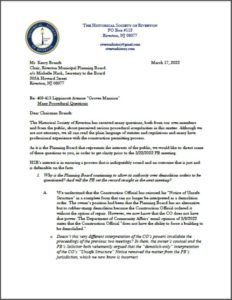 HSR President (and former Riverton Mayor) Bill Brown has delivered a letter to the Riverton Planning Board which details the many “questions about perceived serious procedural irregularities” HSR has received regarding hearings on the Groves Mansion at 411 Lippincott Avenue. Read the letter HERE.
HSR President (and former Riverton Mayor) Bill Brown has delivered a letter to the Riverton Planning Board which details the many “questions about perceived serious procedural irregularities” HSR has received regarding hearings on the Groves Mansion at 411 Lippincott Avenue. Read the letter HERE.
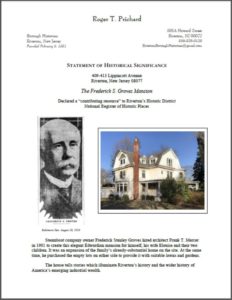 For more information about the fascinating history of the Groves Mansion, see its Statement of Historical Significance by Borough Historian Roger Prichard HERE.
For more information about the fascinating history of the Groves Mansion, see its Statement of Historical Significance by Borough Historian Roger Prichard HERE.
The next Planning Board hearing will be critical to its fate. It will be Tuesday, March 22, 2022, at 7:00, via Zoom at this link: https://zoom.us/j/99667220214?pwd=egmyc1ncm0tmtwruajb6b29dak9zut09
(If it asks for a Passcode, use 813512)

